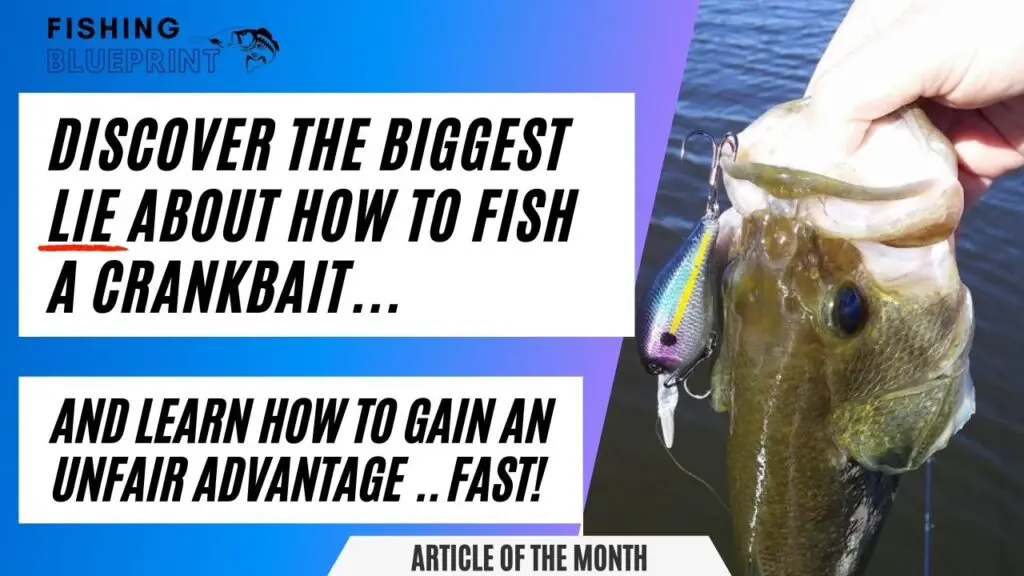New Melones Lake Fishing Report | Fishing New Melones Lake
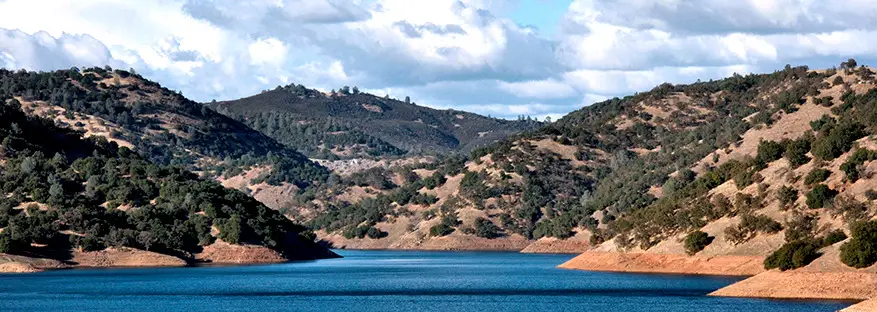
photo: usbr.gov
About New Melones Lake
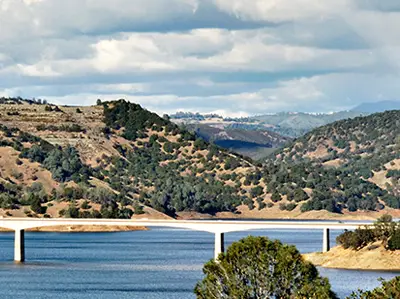
photo: usbr.gov
New Melones Lake was created as part of the Central Valley Project for power, wildlife, flood control, and irrigation water.
Located 141 miles away from San Francisco, overall it’s considered a quiet lake for the weekend angler. And in this post, you’re going to be given the blueprint to fish this lake.
New Melones Lake Is a deep body of water with an average depth being 200 feet and a maximum depth of over 400 feet when the lake is completely full. Furthermore, it’s 12 miles long and 4 miles across. Needless to say, New Melones Lake fishing can go gangbusters when you have 12,500 acres and over 100 miles of shoreline to fish!
Important Lake Warnings
Algae blooms may be present which may affect fishing, swimming, and water contact in general.
According to parks.ca.gov, “every one of California’s new laws requires boat operators to have a California Boating Card. The card is required for anyone under the age of 41 to operate a boat in California’s waters.”
If you are fishing and camping, fire bans may be in effect due to the ongoing drought conditions.
Key Species at New Melones Lake
- Rainbow Trout
- Brown Trout
- Brook Trout
- Chinook/King Salmon
- Kokanee Salmon
- Largemouth Bass
- Smallmouth Bass
- Spotted Bass
- White and Black Crappie
- Bluegill and Sunfish
- Perch
- Catfish
New Melones Lake Fishing Tips
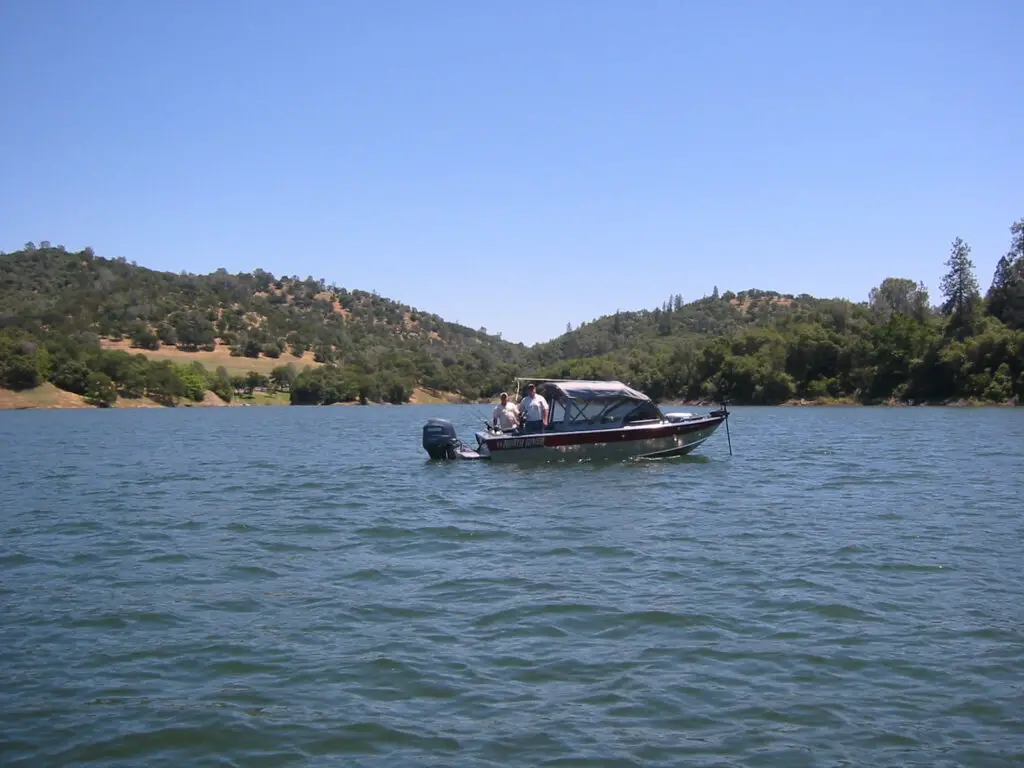
photo: usbr.gov
Water Clarity
The water of New Melones Lake is renowned for being crystal pure, with seasonally visibility of 10 to 30 feet. This is because there is little runoff and sedimentation. It is simpler to see fish in the clear water and choose the appropriate bait for the situation.
Structures and Fishing Cover
New Melones Lake is home to a variety of structures and fishing cover that attract bass and other game fish. Some of the most common structures and fishing cover in the lake include:
- Submerged timber: Bass love to hide in submerged timber, especially in the Glory Hole area and around the lake’s islands.
- Creek mouths and coves: In the spring, focus on fishing in coves and creek mouths where bass are in various stages of pre-spawn, spawn, and post-spawn.
- Points: In the summer, check out the points that drop into deep water.
- Main lake islands: These islands provide great fishing opportunities. Fish the sides that face the wind for largemouth bass, spotted bass, and crappie.
- Deep water: During the summer, bass seek deeper water to escape the heat. So be sure to check out the lake’s main river channel, drop offs, and ledges.
What do these fish eat?
On this lake, the main food source for bass and trout might change depending on the season.
When the water is chilly enough in the spring, trout feed on the many little aquatic animals that are present in shallow water.
The California Department of Fish and Wildlife also supplies the reservoir at this time with thousands of pounds of fingerling and catchable rainbow trout.
Bass, on the other hand, are in various phases of pre-spawn, spawn, and post-spawn in various portions of the lake, and they eat fingerling trout that are fed in the winter and early spring as well as shad and other baitfish.
Both bass and trout become more active and begin to travel into the shallows when the water heats up in the summer. In addition to being present in deeper water, rainbow trout continue to eat on shad and other baitfish.
Trout-pattern swimbaits can be useful for catching huge bass since bass, especially largemouths, are known to eat heavily on fingerling trout in the summer. Throughout the summer, kokanee salmon also eat zooplankton and can be captured by trolling in deep open water.
Both bass and trout move to shallower water in the fall as the water begins to chill off once more and they continue to feast on shad and other baitfish. Because they may feed on insects and tiny fish in creeks with cover like standing timber, brown trout are more likely to be found there.
Springtime Fishing update
My most recent trip at Lake Oroville was crazy due to all the new influx of water. , you’ll find quite pleasant weather conditions for a fantastic fishing experience:
Air Temperature: You can expect temperatures to range from the mid-50s to mid-70s (°F), gradually warming as spring progresses. Mornings can be cool, so pack a light jacket, but by afternoon, you’ll likely be basking in the sun.
Wind Speed & Direction: We saw springtime breezes at the lake are typically mild, with wind speeds averaging 5-10 mph. However, occasional gusts may reach up to 15-20 mph. The wind direction can vary but tends to blow from the southwest, so plan your fishing spots accordingly.
Largemouth, Smallmouth, and Spotted Bass Spawn
- Time of Year: Bass spawning in Lake Oroville typically occurs from late February to May, with the peak happening in April.
- Specific Locations: Some of the best areas for bass spawning include the North Fork, Middle Fork, and South Fork of the lake. Also, keep an eye on shallow flats near primary and secondary points, as well as protected coves.
- Water Temperature: Bass start spawning when water temperatures reach 60-65°F.
Trout Spawning
- Time of Year: Rainbow trout in Lake Oroville tend to spawn during March and April. Keep in mind that brown trout have a slightly different spawning schedule, typically from October to November.
- Specific Locations: Trout often spawn in the North Fork, Middle Fork, and South Fork areas. They prefer gravelly and rocky substrates in streams that feed into the lake, such as Cottonwood Creek, Mud Creek, and Dry Creek.
Water Temperature: Trout spawning usually begins when water temperatures are around 45-55°F for rainbow trout and 44-48°F for brown trout.
Summertime Fishing Forecast On New Malones
Some common weather patterns for New Melones Lake during summer are:
- May: Air temperature ranges from mid-60s to mid-80s°F, with occasional thunderstorms and wind speeds around 5-10 mph.
- June: Air temperature ranges from mid-70s to mid-90s°F, with clear skies and wind speeds around 5-10 mph.
- July: Air temperature ranges from mid-80s to mid-100s°F, with very little precipitation and wind speeds around 5-10 mph.
- August: Air temperature ranges from mid-80s to mid-100s°F, with occasional thunderstorms and wind speeds around 5-15 mph.
Primary forage of bass during the summer in New Melones Lake includes threadfin shad, crawfish, and bluegill.
Here are 5 common baits, including brands, to catch trout and kokanee in the summer at New Melones Lake:
- Needlefish by Luhr Jensen
- Kastmaster by Acme Tackle
- Hoochies by Mack’s Lure
- Triple Teasers by Wedding Ring Lures
- Apex Lures by Hot Spot
Here are 5 common baits, including brands, to catch bass in the summer at New Melones Lake:
- Roboworms by Roboworm
- Senkos by Yamamoto
- Strike King Square Bill Crankbaits
- Keitech Swimbaits
- Spinnerbaits by Booyah
Three specific location names where you can catch bass and trout on New Melones Lake are:
- Tuttletown Recreation Area
- Glory Hole Recreation Area
- Angels Creek
Other types of game fish you can catch in New Melones Lake include:
- Kokanee salmon: These fish are most commonly caught in the summer months using trolling techniques with lures such as dodgers and hoochies.
- Catfish: These fish are typically caught in the summer using bait such as nightcrawlers, chicken liver, or stink bait.
- Crappie: These fish can be caught year-round, but are most commonly caught in the summer months using jigs or small minnows around submerged structure.
- Bluegill/Sunfish: These fish can be caught using small jigs or worms fished around submerged structure, particularly in the summer months.
But Where Are The Best Places To Fish At New Melones Lake?
And in no particular order here is that list of some the best fishing spots at New Melones Lake.
DISCLAIMER: It’s completely impossible to give you every single spot where you can potentially catch a fish in New Melones Lake. But, what this list does do is to give you a helping hand and narrow down to the most productive fishing spots.
Angels Arm
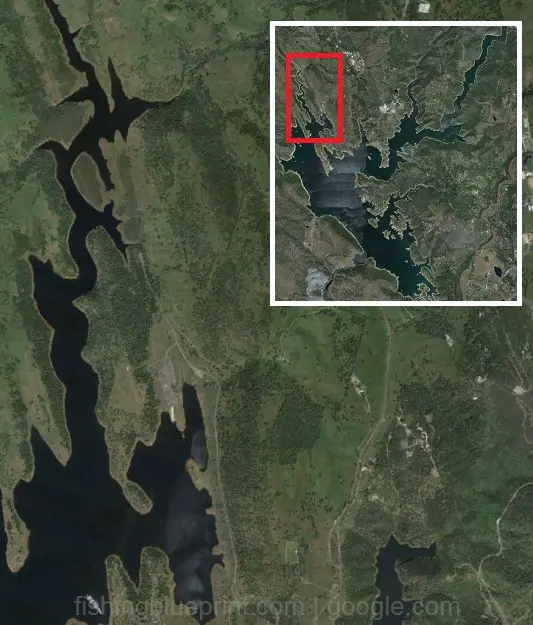
This long arm of the lake is fed by several feeder creeks. It’s thick with submerged brush and standing timber. Large rock piles also dot this area.
This is a good arm of the lake to fish year round.
In the summer look for bass and crappie on main lake points, humps and standing timber. In the fall concentrate your efforts back in the lake arm channel bends to find bass chasing shad.
Effective baits for this area include: topwater lures, flutter spoons, buzzbaits, crankbaits, soft plastic swimbaits, spinnerbaits, chatterbaits, jerkbaits, swim jigs, hair jigs, and underspin jigs when the bass are aggressive.
If the bass are timid, then drop shot, tubes, Ned rig, Neko rig, Mojo rig, Carolina rig and football jigs all work really well.
Located: southwest section of the lake
Structural features: Steep walled lake arm with several sharp creek channel bends, submerged brush and standing timber, large rock piles.
Best species to target: Bass, crappie, catfish
Most effective way to fish this spot: Boat, kayak, float tube, shoreline
Vonich Cove
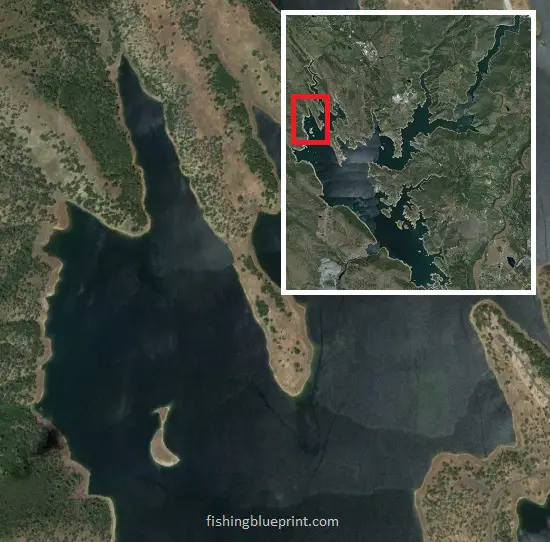
At times the fishing here can be extremely good.
If the rains flood this section of the lake it creates an area of submerged brush and timber, along with cuts and runoff channels which can be excellent for largemouth bass and crappie.
Effective baits for this area include: topwater lures, flutter spoons, buzzbaits, crankbaits, soft plastic swimbaits, spinnerbaits, chatterbaits, jerkbaits, swim jigs, hair jigs, and underspin jigs when the bass are aggressive.
If the bass are timid, then drop shot, tubes, Ned rig, Neko rig, Mojo rig, Carolina rig and football jigs all work really well.
Located: southwest section of the lake
Structural features: flooded flat of thick brush and small trees. Cuts and humps are common.
Best species to target: Largemouth bass and crappie
Most effective way to fish this spot: Boat, kayak, float tube
Vermont Bar to Glory Hole Point
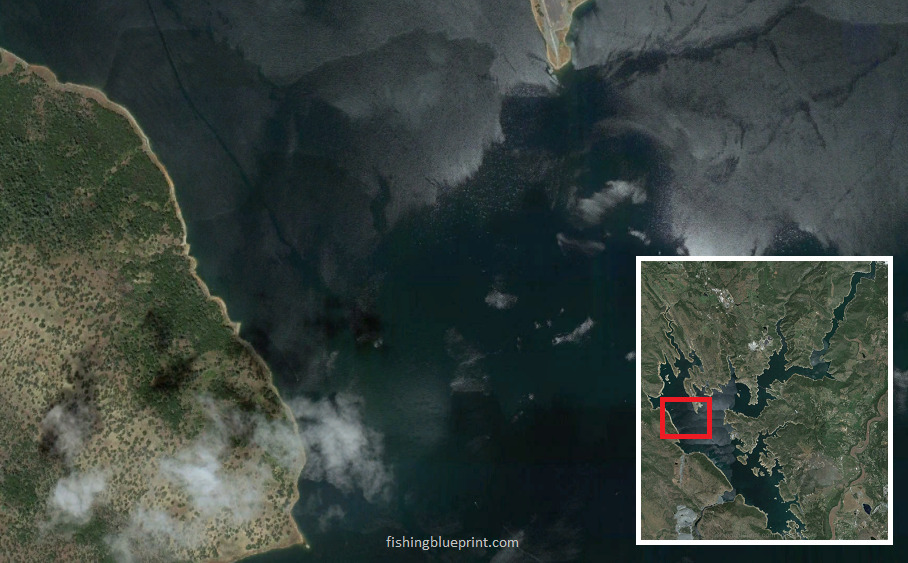
This section of the lake offers anglers submerged natural humps and ridges to target primarily when trolling for trout, kokanee, and salmon.
In the winter and spring this area can be great and trout will hold between 20-40 feet so you can get away trolling without a downrigger.
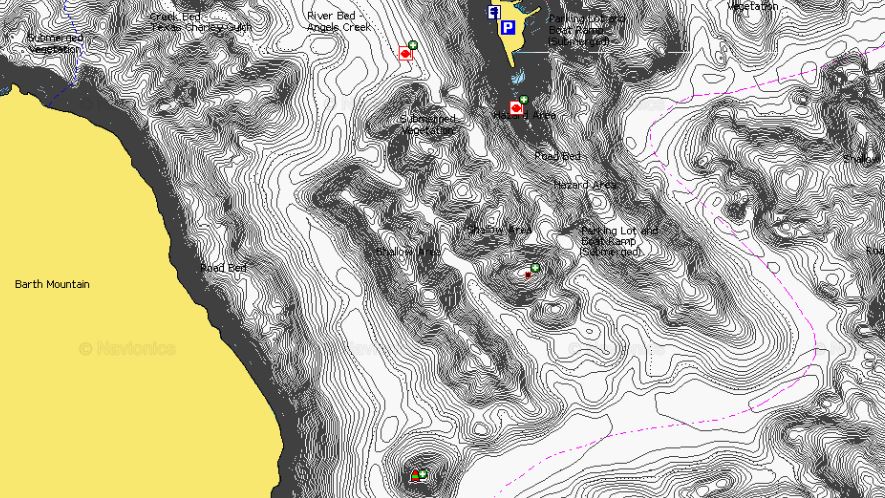
As you can see, there are several high spots and ridges that trout and salmon love to hold over especially during the summer.
However, during the summer these fish will be holding deep in 80-100-feet of water, so trolling with a good downrigger is a must in order to catch them.
Fishing on New Melones Lake can be very windy and can quickly blow you off your spot. That is why it’s strongly recommended you use a quality drift sock to keep your drift at the perfect speed.
Located: south section of the lake
Structural features: natural humps, bars and ridges
Best species to target: Trout, kokanee, and salmon
Most effective way to fish this spot: boat, kayak
Middle Bay
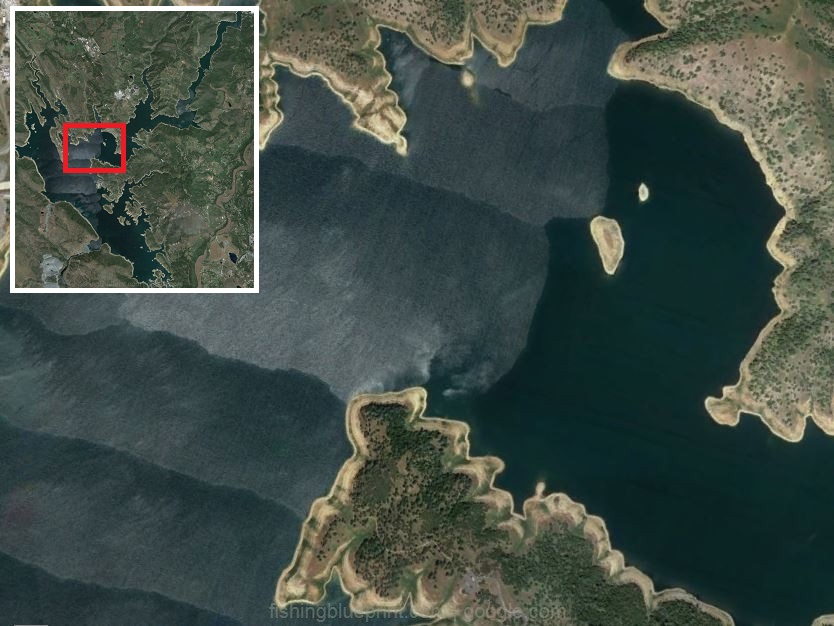
Middle Bay is another section of the lake that offers anglers a chance to fish for trout, kokanee, or salmon.
This area primarily has submerged river channel ledges and steep dropping points.
In the winter and spring this area can be great and trout will hold between 20-40 feet so you can get away trolling without a downrigger.
However, during the summer these fish will be holding deep in 80-100-feet of water, so trolling with a good downrigger is a must in order to catch them.
Fishing on New Melones Lake can be very windy and can quickly blow you off your spot. That is why it’s strongly recommended you use a quality drift sock to keep your drift at the perfect speed.
Some of the effective baits for this area include: Fish attractor (ie: flasher or dodger), trolling spoons, inline spinners, Rapala minnows, Quick Fish, streamers and flies. You can also use real or artificial corn, natural salmon eggs, artificial salmon eggs, real worms such as meal worms or nightcrawlers, artificial worms, and dough bait. Better yet, just buy a complete done-for-you trout lure kit!
Located: middle section of the lake
Structural features: natural humps, bars and ridges
Best species to target: Trout, kokanee
Most effective way to fish this spot: boat, kayak
Carson Creek
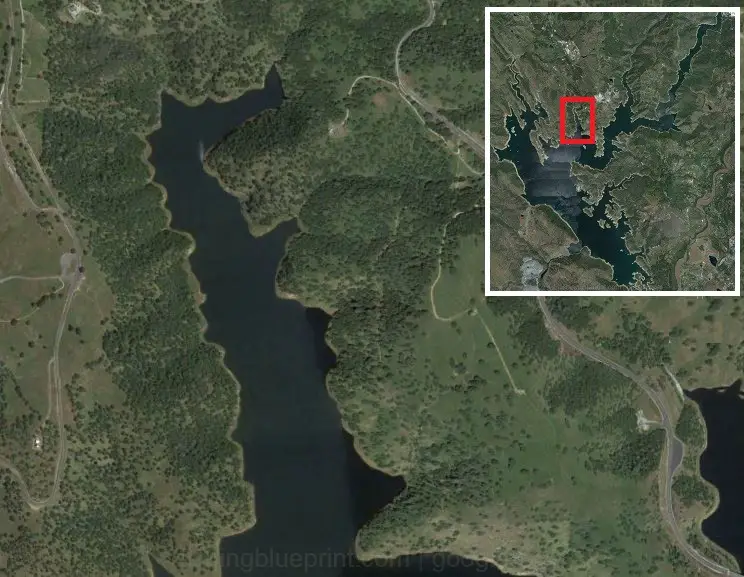
Carson creek is a small arm extending off middle bay that can be a good smallmouth and spotted bass location during the summer.
The secret to fishing this location is targeting the isolated rock piles and bedrock patches. Scanning the area with a fish finder to check for fish holding over the rocks is a must prior to fishing this area.
If the water level of the lake is really low, largemouth bass and crappies will hold in the submerged vertical timber.
The main lake points of Carson Creek should always be checked for bass. The mouth of the creek can have trout suspended in the middle of it.
Believe it or not, this cove is great for spawning bass.
Effective baits for this area include: topwater lures, buzzbaits, crankbaits, chatterbaits, soft plastic swimbaits, spinnerbaits, jerkbaits, swim jigs, hair jigs, and underspin jigs when the bass are aggressive. Flutter spoons work great when used over any deep structure or vertical timber as well.
If the bass are timid, then drop shot, tubes, Ned rig, Neko rig, Mojo rig, Carolina rig, and football jigs all work really well.
Located: middle section of the lake
Structural features: Steep walled lake arm with several sharp creek channel bends, submerged brush and standing timber, large rock piles.
Best species to target: Bass, crappie, catfish
Most effective way to fish this spot: Boat, kayak, float tube, shoreline
Coyote Arm
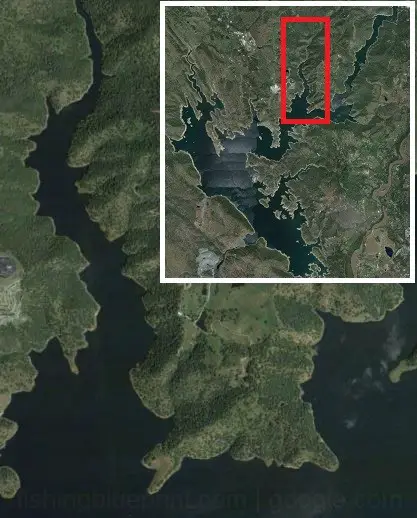
This long arm of the lake is long and steep and in some sections has sharp bends.
This is a good arm of the lake to fish year round.
An interesting feature is that this arm of the lake sits just downstream from a natural narrowing of the river channel, which causes a funnel.
This funnel feature allows predator fish like bass, trout, kokanee, and salmon to position themselves just downstream and wait for baitfish.
Another cool feature about his arm is that it has a natural ridge in the middle of it. In the summer this ridge should be checked for bass.
If the water level of the lake is really low, largemouth bass and crappies will hold in the submerged vertical timber.
Some of the effective baits for trout this area include: Fish attractor (ie: flasher or dodger), trolling spoons, inline spinners, Rapala minnows, Quick Fish, streamers and flies. You can also use real or artificial corn, natural salmon eggs, artificial salmon eggs, real worms such as meal worms or nightcrawlers, artificial worms, and dough bait. Better yet, just buy a complete done-for-you trout lure kit!
Effective baits for bass this area include: topwater lures, buzzbaits, crankbaits, soft plastic swimbaits, spinnerbaits, jerkbaits, chatterbaits, swim jigs, hair jigs, and underspin jigs when the bass are aggressive. Flutter spoons work great in the deeper channel sections as well.
If the bass are timid, then drop shot, tubes, Ned rig, Neko rig, Mojo rig, Carolina rig and football jigs all work really well.
Located: middle section of the lake
Structural features: Steep walled lake arm with several sharp creek channel bends, located just downstream to a natural funnel, submerged brush and standing timber, large rock piles.
Best species to target: Bass, crappie, trout, kokanee, and salmon
Most effective way to fish this spot: Boat
Horseshoe Bend | Quail Flat | Devils Canyon
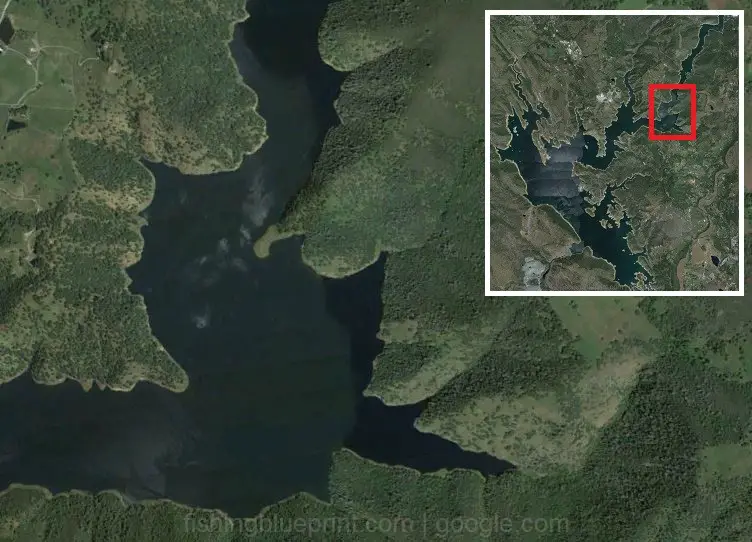
Further up the river a sharp bend to the east marks the location of Horseshoe Bend as more of a collective area of fishing spots, rather than a singular location. This spot is also home to Quail Flat, and Devils Canyon.
Fishing is best by targeting the inner bend and all the small washout coves the current creates.
Furthermore, anglers can choose to also fish rocky bluff walls just off the main river channel.
Additionally, there is a mid-bend hump that extends from the inside bend of the section. The inside bend is littered with rock piles and submerged brush and standing timber. Which is great for all species of bass that can be caught here.
Devils Canyon can be great in the spring and moving baits work very well here.
Quail Flat also features rock piles and submerged brush and standing timber. Which is great for all species of bass that can be caught here. This area can also be good for spawning smallmouth bass in the spring.
Some of the effective baits for trout this area include: Fish attractor (ie: flasher or dodger), trolling spoons, inline spinners, Rapala minnows, Quick Fish, streamers and flies. You can also use real or artificial corn, natural salmon eggs, artificial salmon eggs, real worms such as meal worms or nightcrawlers, artificial worms, and dough bait. Better yet, just buy a complete done-for-you trout lure kit!
Effective baits for this area include: topwater lures, buzzbaits, crankbaits, soft plastic swimbaits, spinnerbaits, jerkbaits, chatterbaits, swim jigs, hair jigs, and underspin jigs when the bass are aggressive. Flutter spoons work great in the deeper channel sections as well.
If the bass are timid, then drop shot, tubes, Ned rig, Neko rig, Mojo rig, Carolina rig and football jigs all work really well.
Located: north section of the lake
Structural features: sharp river bend, cuts, rock piles, southern facing flat, submerged brush and standing timber
Best species to target: Bass, trout, kokanee
Most effective way to fish this spot: boat
Parrots Ferry Bridge to Skunk Gulch
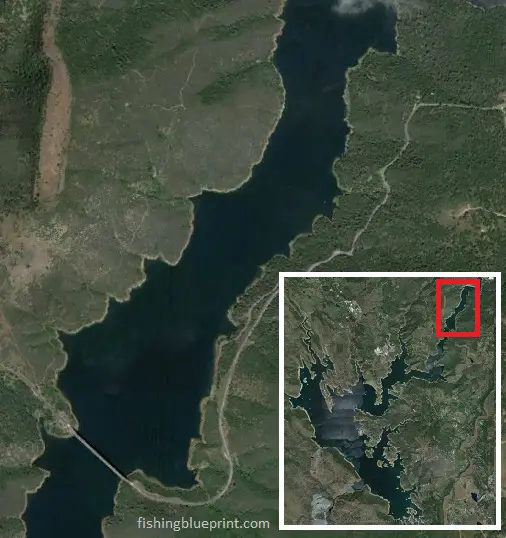
This narrow section of the Stanislaus river is an area to fish for trout, kokanee, or salmon.
Best described as steep canyon walls, the river channel has steep ledges and rapid dropping points where the fish like to hold over.
Fishing closer to the banks (ie over the boulder piles and ledges) are great during the late spring and early summer. Otherwise they will migrate to the main lake and suspend deep in 80-100-feet of water, so trolling with a good downrigger is a must in order to catch them.
In the winter and late spring trout will suspend between 20-40 feet in the middle of the river channel, so you can get away trolling without a downrigger.
Fishing on New Melones Lake can be very windy and can quickly blow you off your spot. That is why it’s strongly recommended you use a quality drift sock to keep your drift at the perfect speed.
Some of the effective baits for trout this area include: Fish attractor (ie: flasher or dodger), trolling spoons, inline spinners, Rapala minnows, Quick Fish, streamers and flies. You can also use real or artificial corn, natural salmon eggs, artificial salmon eggs, real worms such as meal worms or nightcrawlers, artificial worms, and dough bait. Better yet, just buy a complete done-for-you trout lure kit!
Located: north section of the lake
Structural features: steep cold river channel, boulder piles, ledges, points and cuts.
Best species to target: Trout, kokanee and salmon
Most effective way to fish this spot: boat
Mormon Creek Arm
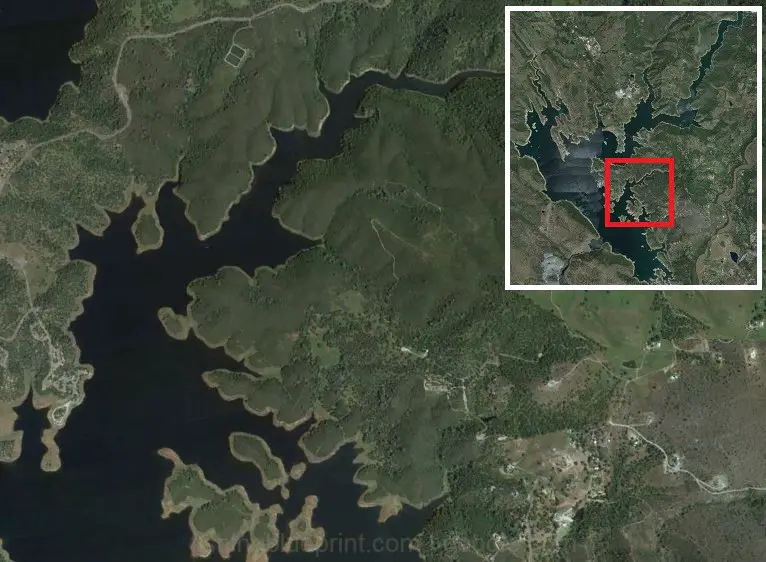
Mormon creek arm is a unique section of the lake. The mouth of the lake is filled with humps and creek channels, additionally isolated rock piles, brush piles and standing timber fill this area.
This combination of humps, runoff channels, and submerged structure can be excellent for largemouth bass and crappie during the summer and early fall.
Bass will migrate into the creek in the spring and late fall and can be caught on secondary points, ledges, channels and drop offs.
Mormon Creek also has several south facing banks and flats where the bass and crappie will spawn.
Effective baits for this area include: topwater lures, buzzbaits, frog lures, crankbaits, soft plastic swimbaits, spinnerbaits, jerkbaits, chatterbaits, swim jigs, hair jigs, and underspin jigs when the bass are aggressive. Flutter spoons work great in the deeper channel sections and above any vertical timber as well.
If the bass are timid, then drop shot, tubes, Ned rig, Neko rig, Mojo rig, Carolina rig, and football jigs all work really well.
Located: southeast section of the lake
Structural features: humps, creek channels, isolated rock piles, brush piles, standing timber, secondary points, ledges, channels and drop offs
Best species to target: Bass and crappie
Most effective way to fish this spot: Boat, kayak, float tube, shoreline
Long Gulch Cove & Peoria Cove
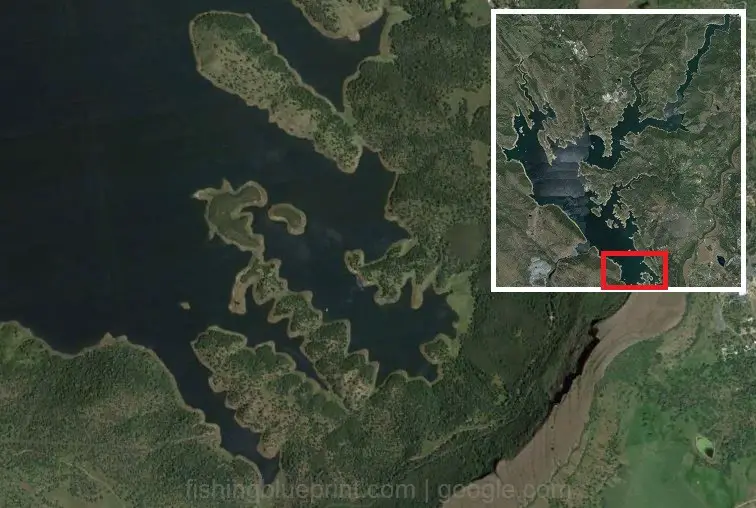
These two coves are great opportunities to catch largemouth bass, spotted bass, and crappie.
Being relatively shallow, the area is filled with humps and creek channels and brush piles. During the warm months, anglers will find patches in and standing timber.
The best strategy to fish this area would be to fish the grass lines in the morning and target the edges of standing timber in the later afternoon.
This area can be pretty good to target spawning bass.
Effective baits for this area include: topwater lures, buzzbaits, frog lures, crankbaits, soft plastic swimbaits, spinnerbaits, jerkbaits, chatterbaits, swim jigs, hair jigs, and underspin jigs when the bass are aggressive. Flutter spoons work great in the deeper channel sections and above any vertical timber as well.
If the bass are timid, then drop shot, tubes, Ned rig, Neko rig, Mojo rig, Carolina rig, and football jigs all work really well.
Located: southeast section of the lake
Structural features: humps, creek channels, isolated rock piles, brush piles, standing timber, secondary points, ledges, channels and drop offs
Best species to target: Bass and crappie
Most effective way to fish this spot: Boat, kayak, float tube, shoreline
South Bay Trolling Circuit: Tuttletown Ramp - Rose Island - South Bay Dam Buoy Line - Spillway
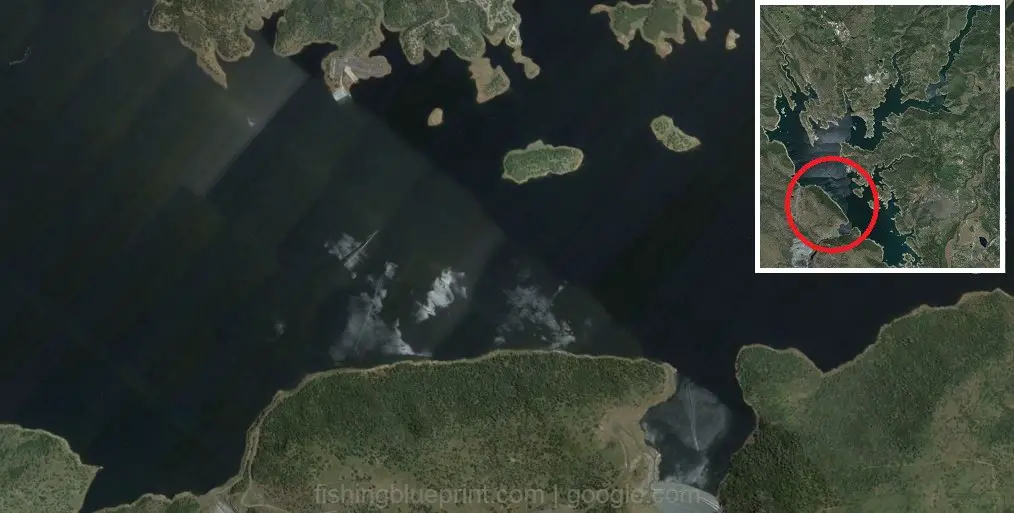
The South Bay trolling circuit is another section of the lake that offers anglers a chance to fish for trout, kokanee, or salmon.
This area consists of trolling between the river channel ledges and steep drop offs between Tuttletown ramp, southwest side of Rose Island, to the mouth of the dam, to the Spillway.
In the winter and spring this area can be great and trout will hold between 20-40 feet so you can get away trolling without a downrigger.
However, during the summer these fish will be holding deep in 80-100-feet of water, so trolling with a good downrigger is a must in order to catch them.
Some of the effective baits for trout this area include: Fish attractor (ie: flasher or dodger), trolling spoons, inline spinners, Rapala minnows, Quick Fish, streamers and flies. You can also use real or artificial corn, natural salmon eggs, artificial salmon eggs, real worms such as meal worms or nightcrawlers, artificial worms, and dough bait. Better yet, just buy a complete done-for-you trout lure kit!
Located: south section of the lake
Structural features: natural humps, bars and ridges
Best species to target: Trout, kokanee
Most effective way to fish this spot: boat, kayak
Boat Ramps at New Melones Lake
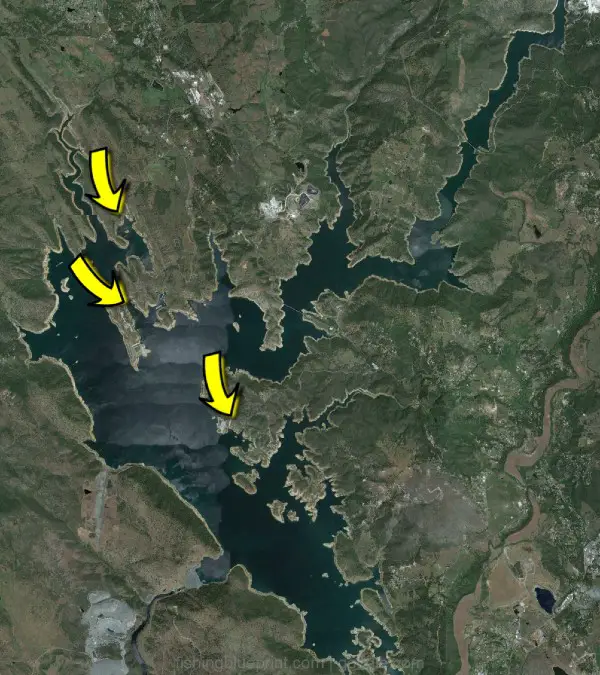
Glory Hole Point at Glory Hole Recreation Center
- Public: Yes
- Location: Near the Marina
- Address: 6503 Glory Hole Rd. Angels Camp, CA 95222
- Phone number: 209-536-9094
- Number of lanes: 2
- Bathrooms: Yes
- Showers: No
- Electric: No
- Camping nearby: Yes 144 sites
Angels Creek in Glory Hole Recreation Center
- Public: Yes
- Location: Near the Angel Creek Hiking trail
- Address: 503 Glory Hole Rd, Angels Camp, CA 95222
- Phone number: (209) 536-9094
- Number of lanes: 2
- Bathrooms: No
- Showers: No
- Electric: No
- Camping nearby: Yes
Tuttletown Boat Ramp
- Public: Yes
- Location: Near the Tuttletown Recreation Area
- Address: Reynolds Ferry Rd, Sonora, CA 95370
- Phone number: (209) 536-9094
- Number of lanes: 4
- Bathrooms: No
- Showers: No
- Electric: No
- Camping nearby: Yes
Marinas at New Melones Lake
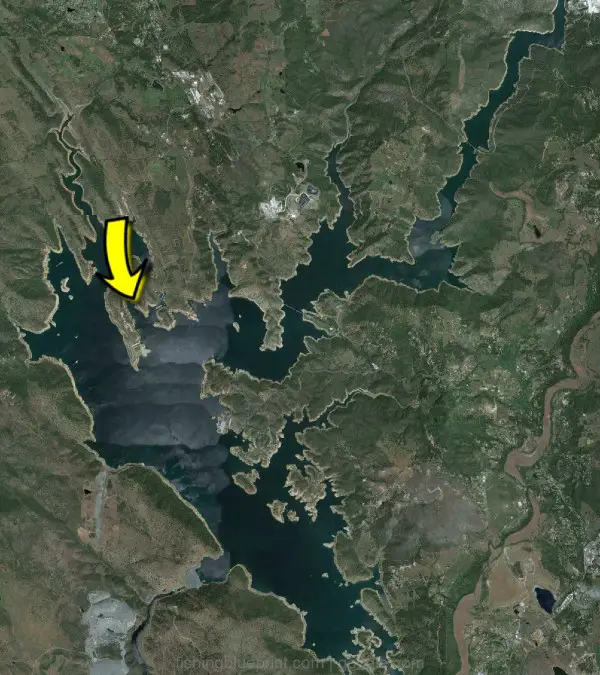
New Malones Lake Marina
- Public: Yes
- Location: Glory Hole Recreation area in Angels Camp, CA
- Address: 6503 Glory Hole Rd. Angels Camp, CA.95222
- Phone number: 209-785-3300
- Number of lanes: 1
- Bathrooms: Yes
- Showers: No
- Electric: Yes
- Camping nearby: Yes
Campgrounds at New Melones Lake
Glory Hole Campgrounds
- Sites – # total. 144
- RV – Yes no hookups
- Standard sites – 122 (11 ADA sites)
- Walk-in tent sites – 20
- Availability – here
- Dump station available: Yes for a small fee
- Fish cleaning station available: yes
- Flush Toilet: Yes
- Shower: Yes/Coin run
- Low season: October – March
- High season: April – September
- Pets welcome: Dogs on leash
- Campground map – click here
- Reservations – click here
Tuttletown Recreation
- Sites – # total. 164
- RV – Yes no hookups
- Standard sites – 142 (11 ADA sites)
- Walk-in tent sites – 22
- Availability – here
- Dump station available: Yes for a small fee
- Fish cleaning station available: yes
- Low season: October – March
- High season: April – September
- Pets welcome: Dogs on leash
- Campground map – click here
- Reservations – click here
Tackle Shops & Tackle Retailers Near New Melones Lake
Glory Hole Sports
Excellent service and excellent tackle right on the water’s edge. Fishing equipment, water toys, and even toys to tow behind your boat are all available. Restrooms that are clean.
- Address - 2892 CA-49, Angels Camp, CA 95222
- Phone number - (209) 736-4333
- Website - here
- Payment methods accepted - Cash, credit, debit, apple pay
The Trout Spot
A large assortment of flies, rods, and fly-tying supplies are available. If you live out of state, you may have everything mailed to you. The rates are fantastic, the shipment is quick, and the internet variety is fantastic. When they run out of a certain tying item, they will go to great lengths to obtain it.
- Address - 2037 CA-4 Suite A, Arnold, CA 95223
- Phone number - (800) 822-7129
- Website - here
- Payment methods accepted - Cash, credit, debit, apple pay
New Melones Lake Marina
Excellent facilities, friendly personnel, and up-to-date tackle inventory. Sandwiches are quite tasty. The Marina functions like a well-oiled machine. The staff are among the most helpful, friendly, and hardworking I’ve encountered. The shop is well-stocked and bustling with customers. Here, renting a houseboat is fantastic and very easy.
- Address - 6503 Glory Hole Rd, Angels Camp, CA 95222
- Phone number - (209) 785-3300
- Website - here
- Payment methods accepted - Cash, credit, debit, apple pay
Other California Related Fishing Articles
- Bass Lake Fishing Report
- Clear Lake Fishing Report
- Castaic Lake Fishing Report
- California Delta Fishing Report
- Diamond Valley Lake Fishing Report
- Don Pedro Reservoir Fishing Report
- Eagle Lake Fishing Report
- El Capitan Reservoir Fishing Report
- Lake Berryessa Fishing Report
- Big Bear Lake Fishing Report
- Folsom Lake Fishing Report
- Irvine Lake Fishing Report
- Lake Almanor Fishing Report
- Lake Camanche Fishing Report
- Lake Isabella Fishing Report
- Lake Havasu Fishing Report
- Lake McClure Fishing Report
- Lake Oroville Fishing Report
- Lake Perris Fishing Report
- Lake Piru Fishing Report
- Lake Skinner Fishing Report
- Lake Tahoe Fishing Report
- Los Banos Reservoir Fishing Report
- New Hogan Lake Fishing Report
- New Melones Lake Fishing Report
- O’Neill Forebay Fishing Report
- Pardee Lake Fishing Report
- Pyramid Lake Fishing Report
- San Luis Reservoir Fishing Report
- San Vicente Reservoir Fishing Report
- Shasta Lake Fishing Report
- Silverwood Lake Fishing Report
- Trinity Lake Fishing Report
- Whiskeytown Lake Fishing Report
More articles just for you...
Funny Fishing Rules, Laws, and Regulations 2025
Crazy Fishing Laws That Will Blow Your Mind! #7 is INSANE! Strange Fishing Regulations and Laws As silly as hook and rod limits may seem,
EXPOSED! How To Use A Spinnerbait The Right Way for 2025
Are You Wondering How To Use A Spinnerbait? Or How To Work A Spinnerbait Over Grass, Logs, or Points? Well, All These Questions Are Answered
EXPOSED! Best Crankbait Colors for 2025 [Which to Buy & Avoid]
What color crankbait to use? Crankbait Color Chart I just love going into a Bass Pro Shops store and just staring at all the walls
Best Underwater Dock Lights For Fishing – 2025 Buyers Guide
Night Dock Light Fishing For Beginners Dear fellow angler, Does this sound like you? You’re someone who loves fishing but just wants to escape the
15 Best Deep Diving Crankbaits [2025 Buyers Guide – Which to Buy & Avoid]
A Complete Buyer’s Blueprint On The Best Deep Diving Crankbaits for Bass, Walleye, or Striped Bass On The Market Today Fishing deep diving crankbaits can

